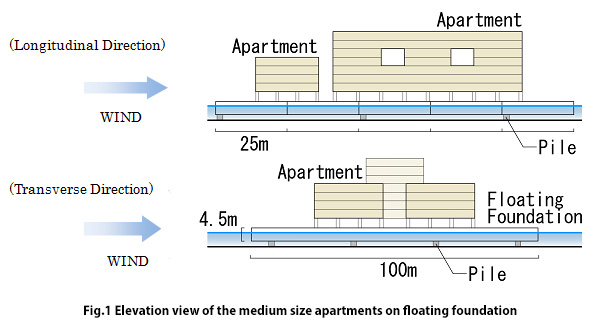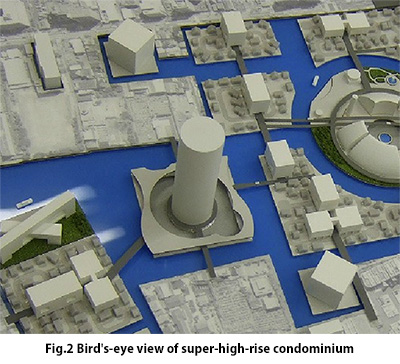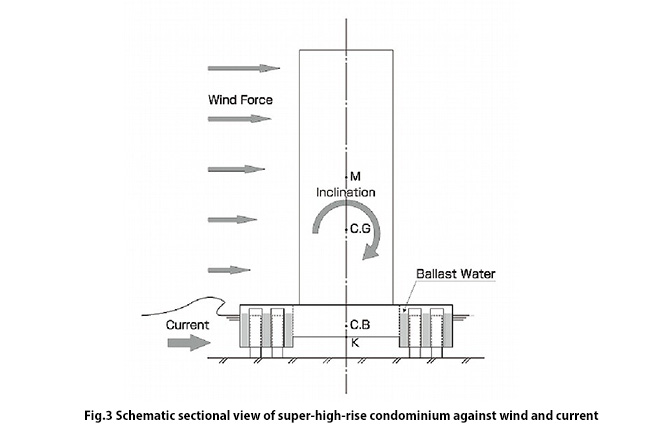
Engineering Aspects
1. General
Although floating structures suffer from non-linear high waves and many kinds of currents in the open sea, the sea-keeping capability of those inside calm man-made reservoir seemed to be excellent and stable. We therefore had noticed we could use floating structures shown in as the different solution against disastrous flooding due to global climate change and sea level rise. Though most people worry about capsizing, sinking of floating structures and other phenomena seen at sea in general, we can easily persuade these people simply by explaining that in our case the water depth is close to the bottom of floating foundations. Against earthquakes, since floating units are buffered from the full brunt of the tremor thanks to the dampening effect of water, they can be considered to be safer than structures that sit directly on top of the ground. The floating unit used in this proposal considerably minimizes the influence of earthquakes for two reasons. One is that water serves to dampen the platform motion caused by seismic motion in the horizontal direction. The other is that the natural period of vertical and horizontal platform motions become longer than that in air due to the increase in the virtual mass of the platform in water. The result is that the tuning between the earthquake and the platform motion is avoided.
2. Stability of the floating foundation and the inclination due to wind
At first, the vertical location of central gravity of the rectangular shaped floating foundation consists of 5 modular units with buildings (100 m in width, 125 m in length and 3.0 m in draft), ballast waters and so on is calculated to be 7.47 m (KG) while the meta-centric heights (GM) in transverse and longitudinal directions for the floating foundation consists of 5 floating modular units are 277.8 m and 434.0 m, respectively. These values indicate that the floating foundation is quite stable against strong winds. In fact, the calculated heeling angles of the floating foundation when considered from the maximum recorded wind speed of 39.6 m/s at Tokyo area, this maximum having been reached during a storm in September of 1917, become 0.04 deg in the transverse direction and 0.01 deg in the longitudinal direction, thus showing that there is an extremely small effect generated due to strong wind (See Fig.1).



Secondly, the similar study on 34 stories high super-high-rise condominium (total height is 120m from the mean water surface) located on the square shaped floating foundation (100 m in width, 100 m in length and 15 m in draft) was conducted. The total dead load of the super-high-rise condominium is estimated as 100,000. t (or 980,000 KN) where the weights of the 34 stories high building and the floating foundation are calculated as 72,400. t and 27,100. t. The vertical location of center of gravity (C.G) for the super-high-rise condominium with buildings, ballast waters and so on is calculated to be 49.14 m (KG) while the meta-centric height (KM) is 83.24 m (See Fig.2). When the design wind speed is assumed to be 50.0 m/s (10 minutes average value at 10 m height) which is more than 39.6 m/s, this maximum in Tokyo area, the approximate horizontal wind load and the heeling angle of the floating foundation are calculated as 15,639 t (or 153,262 KN) and only 1.77 deg., respectively, under free floating condition (without the effect of supporting piles) thus showing that there is a small effect generated due to strong wind. In the calculation, the drag coefficient for tall condominium of circular shape is assumed to be 1.2 and the design wind speeds at different height have been estimated by the one seventh power law (known as the Prandtl-von Karman universal velocity-distribution law) and are used for the calculation of wind heeling moment (1,190,000 KN m) acting on the super-high-rise condominium. The wind speed at the height of 115 m reaches 70.9 m/s according to the calculation. The restoring moment of floating foundation is obtained by the product of the GM value (34.10 m) and the displacement of the floating foundation (115,300 t or 1,130,000 KN) and are 38,535,000 KN m.
3. On the effects of tsunami and/or storm surge on the floating foundation
The height of tsunami at Tokyo area has been estimated by Japanese authority as 2.5 m at most which is a somewhat lower value because the water city is to be located inside enclosed sea surface of Tokyo Bay. Then, for the vertical increase in water depth, it can be assumed that the water level has increased by 2.5 m (changing the water depth to 22.5 m from 20.0 m). In this condition, the floating foundation of the super-high-rise building (100 m in width, 100 m in length and 15 m in draft) rises 1.0 m (not 2.5 m) and the freeboard of the floating foundation becomes 3.5 m from 5.0 m, with the supporting piles being detached from the rubber fender of the floating foundation. In such case that the water level rises more than 2.5 m, the floating foundation moves up more and the deck does not sink at all. This means that the water city is completely secure against rising waters such as flooding.
In case of a tsunami, the concerns as to the current force due to tsunami acting on the floating foundation may be voiced in addition to the vertical increase in water depth. In general, horizontal load of current due to tsunami and/or storm surge on the floating platform of barge type is to be not too large because of the small aspect ratio of the floating foundation. In another words, the most tsunami flow passes through underneath of the floating foundation and then the floating foundation just rides on the tsunami flow. According to computation by the drag force equation for barge type floating foundation of rectangular shape (29 m in width, 76 m in length and 3.8 m in draft; 8,585 t in displacement), the maximum horizontal load for tsunami against the floating foundation and supporting piles is estimated to be only 1,501 t (or 14,801 KN) in the transverse direction which is the largest based on the assumption that the horizontal velocity is 10.0 m/s observed at the water depth of 10 m on land during the huge tsunami in the Indian Ocean in 2004. Here in above calculations of the horizontal natural load on the structure, we assumed the drag coefficient as 1.0 for tsunami and the projected area of the floating foundation is 285.0 ㎡.














